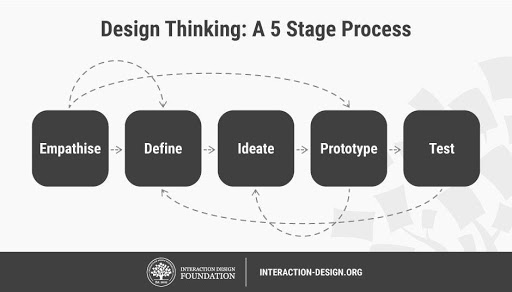
A Simple Guide to Design Thinking for Marketers
Finding and implementing new solutions can feel like an intimidating amount of time and resources. Design thinking has appeared as a solution to this challenge and has become extremely popular in the last several years as an approach to business problem-solving.
Design thinking encourages marketers to be more empathetic in their approach to communicating with customers. Great customer experience has a huge impact on brand preference, loyalty, and the sales rates of a company. The secret to success in your marketing strategy is to develop engagement programs and brand experiences that are consumer-centered. That’s where design thinking comes into play.
What is design thinking?
Generally, design thinking is a design methodology used to solve human-related problems. Contrary to what you might think, it is not about making a brand or a product look trendy in the eyes of the audience. Instead, it is a systematic approach to problem-solving that allows marketers to come up with new and exciting ideas that speak to customers. Design thinking goes beyond the traditional business models and focuses on customer empathy and real-world experiments.
Design thinking empowers marketers to generate quality marketing strategies that will be successful by getting the right content in front of the right sets of eyes. So, whether you are marketing a local business or specific services, it is important to explore and create ideas that better cater to the consumers’ requirements and desires.
The phases of design thinking
Like any other methodology, design thinking needs to follow certain stages or phases that will contribute to the innovative project created by the designers. However, those phases shouldn’t be perceived as a step-by-step process because often they can occur in parallel or require to be repeated.
Let’s take a closer look at the five stages designers should follow:
- Empathize with customers in different situations
- Approach a problem-solving mindset by defining the core problems
- Ideate by generating better solutions to the existing problems
- Imagine ideal user experiences from the customers’ perspective and create prototypes of the product
- Test the complete product to rule out any possible problem

Start from the customer’s point of view
Since marketing is less about money and more about connecting to the customers on the receiving end, successful marketing campaigns need to touch the hearts and souls of the audience. It’s important for marketers to focus not only on the products and services they sell but also on their customer’s experience.
One of the biggest challenges for today’s marketers is reaching the audience on a personalized basis. Since each consumer prefers certain types of channels to engage with businesses, it is very easy for the audience to disengage if marketers don’t reach out to them according to their exact expectations. Yet, just asking customers what they want is not enough, because they are not good at imagining things that don’t already exist.
The whole process of creating a marketing culture around design thinking can be broken down into three key questions:
- What are the customer pain points? This question should make marketers slow down for a little bit and focus on empathy. Before running to the whiteboard to brainstorm ideas, they have to pay attention to what is going on with their customers. You have to get into their everyday lives and homes to determine what problems they’re having and how you can create something that will solve them. Another option is to check the reviews of companies that work in this niche and find out what their customers don’t like about them. It can become your unique selling proposition.
- What if? The “what if” question has always been the best call for creativity and ideation. It is the right step for you to bring along customers, experts, and everyone who has anything to do with the product to generate as many ideas as possible. The more diverse your group of people is, the more creative ideas you will get.
- What works? This is the experimentation stage of the process where what customers want and what businesses can deliver have to meet and create a final product. Evaluate each idea that has been generated and extract concepts that can be produced using the existing resources. Lastly, create prototypes from the ideas, share them and get customers feedback.
Build a team to match your vision
Design thinking is a complex process that helps marketers understand what their customers need and how to create innovative solutions for their problems. It is a multi-step process that needs a diverse set of talents and perspectives to result in innovative concepts. A team that has worked together for too long may face similar points of view that keep newness away.
An effective design team that can create a culture around design thinking has to be a modern one with dissimilar talents. The team should be a cross-functional one that includes customer experience, design, marketing, and IT specialists working toward a common goal.
- Content creation: Content is one of the key roles in any marketing strategy as it helps you attract, engage, and delight customers, and ultimately generate revenue for your company. The content creation team will be responsible for writing blogs, creating videos, and designing infographics. Depending on your needs, you can have an in-house team or work with freelancers or an agency. Each option has its advantages and downsides.
- Acquisition: An effective customer acquisition team is the one that will generate traffic, leads, and front-end sales. Since prospective customers must be fully engaged with your brand before they make a purchase, the acquisition team must build quality relationships with them.
- Monetization: There should be part of your team that will be responsible for turning leads into customers.
There is a multitude of specialized tests you can run for things like situational judgment, professional values, personality traits, and problem-solving capabilities to form a team that includes all the relevant skills for design thinking.
Understand your customers
Naturally, marketers are passionate about getting an extensive understanding of their customers. In the design thinking process, marketers need to do more than just comprehending the customer, they have to put themselves in the shoes of the user, understand their needs, and create concepts and products that are the solutions for their problems.

























